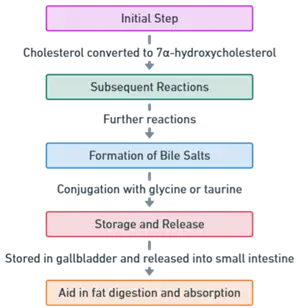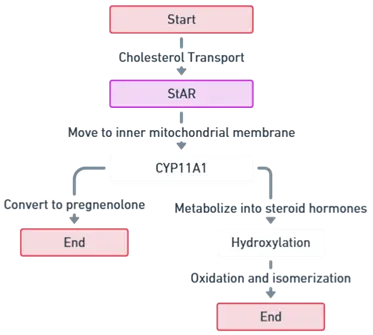- The conversion of cholesterol into bile acids, steroid hormones, and vitamin D refers to the biochemical transformation of cholesterol into essential molecules that play critical roles in digestion, endocrine function, and calcium homeostasis.
- These metabolic pathways occur in different tissues and are tightly regulated to maintain physiological balance.
Conversion of Cholesterol into Bile Acids:
Primary Location:
- Liver
Steps Involved:
-
Initial Step:
- Cholesterol is converted to 7α-hydroxycholesterol by the enzyme cholesterol 7α-hydroxylase (CYP7A1), which is the rate-limiting step in bile acid synthesis.
-
Subsequent Reactions:
- Further hydroxylation, oxidation, and conjugation reactions lead to the production of cholic acid and chenodeoxycholic acid, the two primary bile acids.
-
Formation of Bile Salts:
- These bile acids are conjugated with either glycine or taurine, forming bile salts, which enhances their solubility and effectiveness in emulsifying dietary fats.
-
Storage and Release:
- Bile salts are stored in the gallbladder and released into the small intestine during digestion to aid in the digestion and absorption of fats.

Conversion of Cholesterol into Steroid Hormones:
- Primary Location: Steroidogenic cells in the adrenal cortex, gonads, and placenta.
Steps Involved:

-
Cholesterol Transport:
- Cholesterol is transported from the outer to the inner mitochondrial membrane by steroidogenic acute regulatory protein (StAR).
-
Initial Conversion:
- Cholesterol is converted into pregnenolone by the enzyme cytochrome P450 side-chain cleavage enzyme (CYP11A1 or P450scc). This is the rate-limiting step in steroid hormone synthesis.
-
Steroid Hormone Synthesis:
- Pregnenolone is then metabolized into various steroid hormones, including glucocorticoids, mineralocorticoids, and sex hormones (androgens, estrogens, progestogens) through a series of hydroxylation, oxidation, and isomerization reactions.
Conversion of Cholesterol into Vitamin D:
Process Overview:
- Involves processes in the skin, liver, and kidneys to produce active vitamin D.
Steps Involved:
-
Skin Reaction:
- In the skin, 7-dehydrocholesterol is converted to previtamin D3 upon exposure to UVB radiation. Previtamin D3 then spontaneously isomerizes to vitamin D3 (cholecalciferol).
-
Liver Conversion:
- In the liver, cholecalciferol is hydroxylated by the enzyme 25-hydroxylase (CYP2R1) to form 25-hydroxycholecalciferol (calcifediol).
-
Kidney Conversion:
- In the kidneys, calcifediol is further hydroxylated by 1α-hydroxylase (CYP27B1) to produce the biologically active form, 1,25-dihydroxycholecalciferol (calcitriol).
-
Role of Calcitriol:
- Calcitriol plays a crucial role in regulating calcium and phosphate homeostasis. It enhances the absorption of calcium and phosphate from the intestines and promotes bone health by regulating their levels in the blood.
Thank you for reading from Firsthope's notes, don't forget to check YouTube videos!
